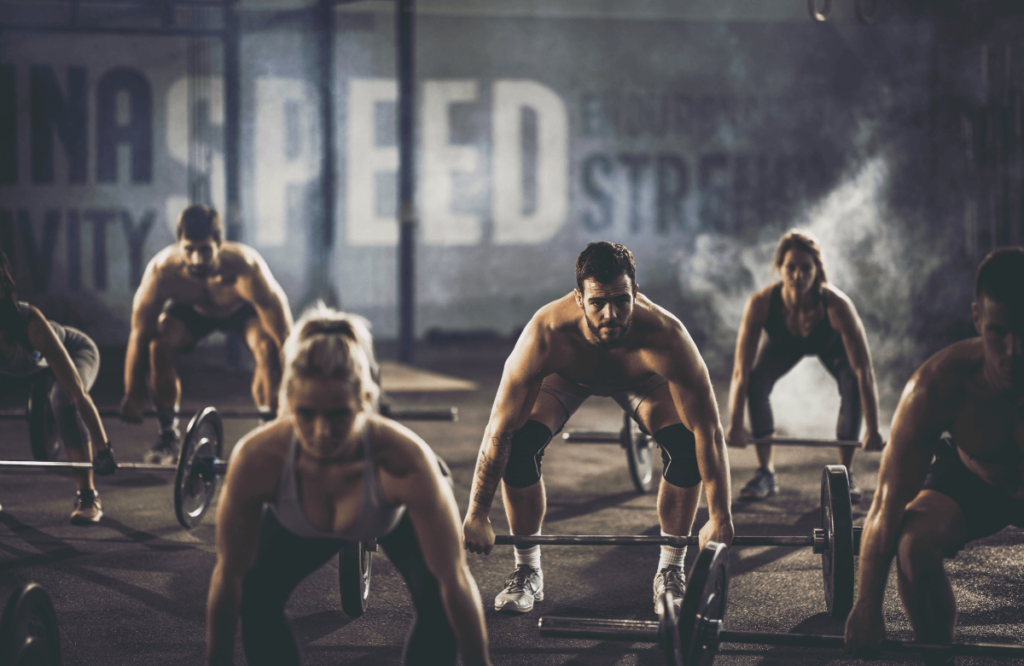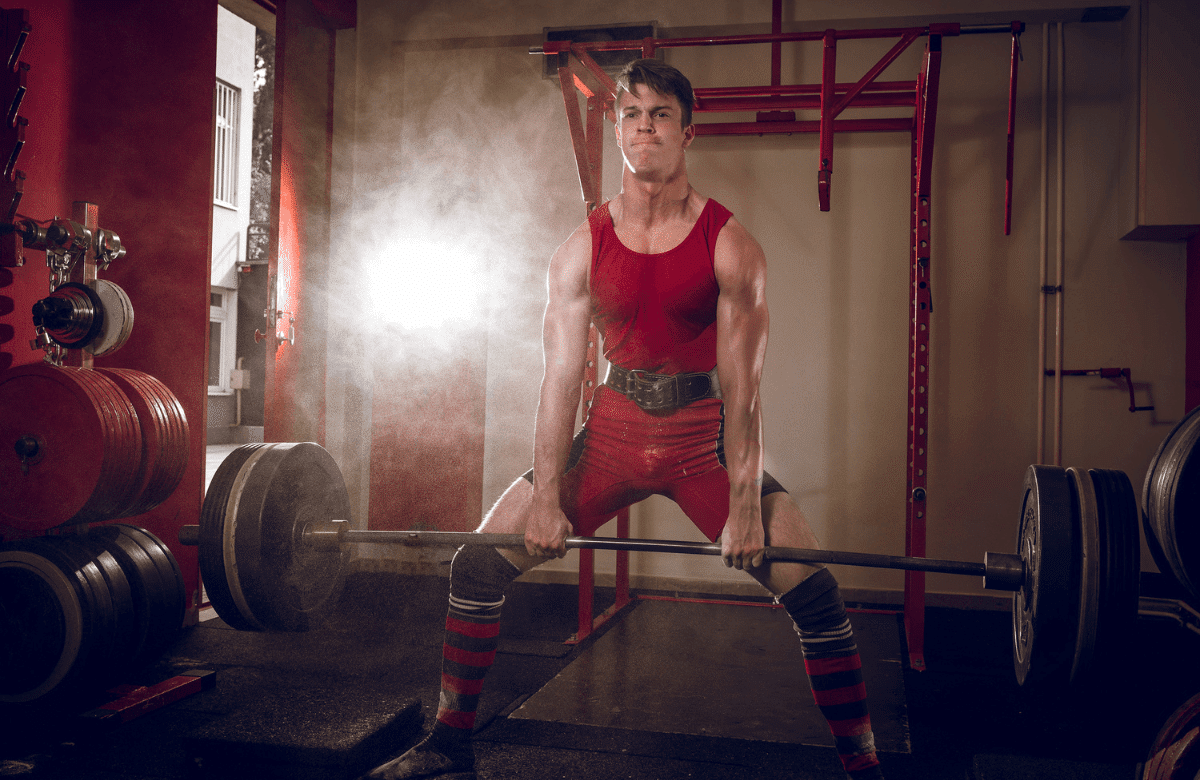There are all kinds of deadlift variations beyond the ‘standard’ deadlift. Sumo stance deadlift, trap bar deadlift, stiff leg deadlift, RDLs, single leg deadlift to name just a few.
They all have their benefits, their nuances and their place in a training program.
In this article we’re going to focus on the sumo stance deadlift. We’re going into detail on what it is, why you’d use it, and how to do it properly.
By the end of the article you’ll be in the know on all things sumo stance deadlift!
Jump to:
Why use a Sumo Stance Deadlift?
The first question to address is why would we use a sumo stance deadlift? With a wide range of deadlift options available to us, why should we use this particular variation of the movement?
Here’s the snapshot…
Reduces lower back pressure
Compared to a conventional stance deadlift, the sumo deadlift stance reduces lower back pressure. This has been shown across various studies, and features significantly in the work of Stewart et al in their 2016 paper on the Sumo Deadlift. A paraphrased element of their research shows…
‘The sumo deadlift requires a stable spine to effectively transfer force across the body when lifting heavy loads. Spinal stabilization primarily involves the erector spinae muscle group. Additionally, the latissimus dorsi also plays an important role in spinal stabilization. Together, this interaction allows effective force transfer between the upper and lower body with the removal of local spinal load.’
This suggests that the unique position and distribution of load is a way of protecting the lower back, whilst still allowing the lifter to perform a deadlift variation.

Variation of forces
The technique used in the sumo stance deadlift is sufficiently different from other variations. This means different forces are applied to the limbs and trunk.
The change in technique means there are greater angles at the hips, knees and ankles during the lift. The distance required to move the bar to completion is reduced. The wider stance reduces the range of movement.
Escamilla et al performed a 3D analysis on both conventional deadlift stance and sumo stance techniques in 2000, and concluded that…
‘Vertical bar distance, mechanical work, and predicted energy expenditure were approximately 25-40% greater in the conventional group.’
This suggests there’s a place for the sumo stance deadlift exercise within deadlift training – it can help focus on leg drive, or even be used during de-loading training phases. The changes in range of movement can also help to focus on specific elements of deadlift technique.
Compliments conventional deadlifts
With such a technical move, including Sumo stance deadlifts in your training can help to compliment your conventional deadlifts.
The adjustments in range of motion, the new movement pattern and the different angles of the hip structure help to recruit the muscles in a new way. This improves your functional strength, which translates into a stronger conventional pull.
A switch up in training approaches helps lifters refocus, and get out of a training rut without compromising muscle and strength gains. Research in 2019 by Baz-Valle et al studied The effects of exercise variation in muscle thickness, maximal strength and motivation in resistance trained men.
They concluded…
‘Varying exercise selection had a positive effect on enhancing motivation to train in resistance-trained men, while eliciting similar improvements in muscular adaptations.’
As the old saying goes, a change is as good as a rest…
Especially tall people benefit
Another reason you might use a sumo pull in your strength training is to help a tall lifter.
If you look at the wide stance of the sumo deadlift technique, you’ll see that the lift starts with the feet wider and a much deeper knee bend compared to the standard deadlift…
This technique means that the distance required to complete the lift is reduced, and this helps to save the lower back of a tall lifter. Although a shorter range might be seen as ‘easier’, it’s still a long way for a tall person to pull the bar.
I almost always use sumo stance deadlifts as an option for lifters over 6’5 or so. As a cost:benefit, it just makes more sense for someone with long body proportions to do a sumo pull than a traditional deadlift.

Sumo Stance Deadlift – Technique Breakdown
Here’s where we get into the ‘how’. There are nuances you can attribute to Sumo deadlift technique, without lessening the effects of the lift. To make life easier, I’ve broken the deadlift into several distinct movements.
Here’s a how-to guide of the main principles…
Open the legs
The main difference between the standard deadlift and the sumo stance deadlift is the leg and foot position.
The legs are opened wider and the feet are turned out. It’s important that during this external rotation of the feet, the knees track in line with the toes. This helps to prevent knee ‘collapse’ inwards, which is essential for proper form in the sumo pull.
This wider stance is a great way to isolate the quads more in the deadlift. It helps build deadlift specific quad strength, complimenting other forms of the lift.

Solid stance
I always teach my lifters that a good lift starts from the ground. You must make sure you have a solid foot placement. A chain is only as strong as its weakest link, and if you aren’t set right from the ground up, it’s all going to go wrong.
Here’s your three step guide to stance…
1. Turn your feet out slightly – on a clock face think 10 and 2.
2. Distribute your weight evenly over your feet – pressure on the heels and balls of your feet should be equal.
3. ‘Screw’ your feet into the floor, ‘switching on’ your feet muscles.
Once you’ve done this, you’re good to move onto the next phase…
Bend your knees
One of the fundamental differences between the traditional deadlift and the sumo stance deadlift is the depth of the knee bend in the start position.
The initial pull starts from a deeper squat stance, so the muscle recruitment is primarily from the quads and glutes in the first instance. This extra emphasis on the quads in the first pull is the reason there is less pressure on the back than in regular deadlifts.
Once your knees are bent sufficiently and your quads are loaded we move onto the next phase…
Grip the bar
There’s no standard grip for the sumo stance deadlift, but there is a width guidance. It has to be inside of the knees, closer together than a regular deadlift grip.
Of course it has to be wide enough to balance the bar – too close and you’ll have a problem with the bar tipping to either side. You’ll also give your forearms nightmares trying to hold on to a heavy bar that way! Instead, shoot for a grip where your hands are around 12 inches apart.
Overhand or alternating grip is generally best. Just grip it tight, then on to the next phase…

Brace your core and back
By this point your knees are bent and your quads are loaded. You’ve got a good, strong grip on the bar. Now it’s time to brace and get ready.
I like the ‘big air’ approach to core bracing. You effectively take in a big breath, filling your lungs and belly with air. Hold this breath, so you can keep your torso rigid whilst you’re lifting. It helps to protect your lumbar spine as you lift.
Sit deep into the start position. Set your back straight and slowly lift yourself up until you’re taking the slack out of the bar. You’re ready to progress to the lift off…
Drive into the floor
You initiate the lift by driving your feet into the floor and extending your legs. Your torso remains straight as you drive through the legs. Keep the bar close to your legs – this is an efficient deadlift bar path.
As the bar passes your knees, your torso should begin to rise upwards. We’re entering the final phase of the pull…
Hip drive
Once the bar has clearly passed your knees and your legs are almost straight, we complete the pull with a hip drive.
We start with the lift with the hips back and down. As you lift, the hips rise, but they’re still slightly hinged. The lift is completed when the hips drive forwards, squeezing the glutes and locking in the lower back.
Pause here for a split second, then reverse the movements. You’ve just performed a safe and effective sumo stance deadlift!
Mistakes to avoid
Deadlifts are a great exercise, but if you don’t perform them well you’re at risk of injury. Even experienced lifters are at risk if they don’t perform their sumo pull with care and consideration.
Here’s three of the most common technique faults within the deadlifting movement, with advice on how to correct each one…
Rounding the upper back
This is the most common fault amongst beginner lifters. It’s often down to either weakness or a lack of rigidity in the spine throughout the lift.
I like my lifters to think about squeezing their shoulder blades together as they perform the lift. It’s impossible to do this with a rounded thoracic spine, so it helps to maintain the lifting and technique discipline throughout the movement.
Not using your legs properly
The wider foot position means that you have to really rely on the leg drive to start the sumo pull. If you don’t get this right, you really limit what you can lift.
I coach this by having my lifters adopt a wider foot position, keep their back straight and only focus on lifting the weight a few inches off the floor. This really helps them to focus on effective movement early in the lift.
The decreased range of movement means there’s plenty of opportunity to focus solely on what the legs are doing.
Early butt rise
I usually see this in lifters who are progressing. They’ve got the leg drive down, but they forget about the torso!
What happens here is that the butt ‘shoots’ up as the legs straighten too quickly. This puts more pressure on the lower back, ruining technique and increasing the injury risk.
My favorite tool for this is the phone video. Filming yourself during your lift, then watching what happens gives you a chance to identify the problem. You can then focus on slowing your leg drive down and keeping your torso angle rigid throughout.
There’s no real ‘drill’ that gets this right – it’s a practice thing. Repetition of good technique works best.

Programming the Sumo Stance Deadlift
The sumo pull is very much a specialist movement, and it is most at home in deadlift workouts or a strength workout. I wouldn’t be including sumo stance deadlifts in my generic training programs.
If you’re a strength coach, or a personal trainer writing a specialist strength program then it’s an effective deadlift variation to include. It helps to improve basic strength and it helps to benefit conventional style deadlifts. When you’ve learned the correct sumo deadlift form, you might even prefer it thanks to the lesser degree to which it impacts the spine.
Sets and Reps
Thanks to the shorter range of motion, the reduced energy cost and the lower spinal loading, you can cope with higher volume sumo stance deadlifting.
You can follow traditional strength training with heavier weight, short rep sets. Alternatively, you can throw a less challenging weight on the bar and use it as an exercise for building strength endurance.
It’s a case of requirements.
The sumo pull is a great exercise for training general or deadlift-specific strength. I wouldn’t use it for super high (15+) rep work, but instead focus on sets of 1-6 reps. That’s generally your sumo deadlift sweet spot.
If you haven’t added sumo stance deadlift to your programming, it’s worth doing so. It adds a nice variation to your training and forces you to learn a new movement. The wider stance sumo deadlift is a great way to ‘shock’ your legs into building additional quad strength too!














